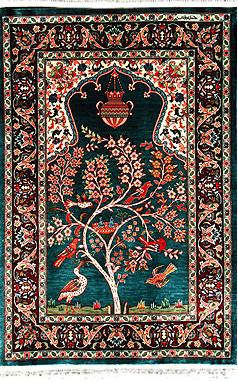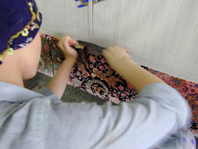For those who have everything! Looking something for special? It is one of beautiful Hereke silk rugs considered as fine art. Connoisseurs worldwide agree that nothing finer exists than the Hereke Pure Silk Carpet. All controversy ceases in the presence of the genuine article! And this is it….a most carefully chosen Hereke silk carpets handmade masterpiece!
Technically not a tapestry, of course, but a Hereke silk rug, it should be hung upon a wall for a perpetual enjoyment. It is very finely and expertly woven with a reverse side that approaches perfection. The weaver probably spent eleven months or moreproducing it. Every thread of the warp, every thread of the weft, and every tuft of the pile of this hand woven beauty is 100% pure silk. Each is double-knotted by hand. It is a Hereke Pure silk rug woven in Turkey in the famous Turkish tradition of durability and excellence which dates back to 400 AD.
 The town of Hereke itself was established a mere 200 years ago by the Sultans as a production center for the ultimate sensual luxury , the all silk carpet.
The town of Hereke itself was established a mere 200 years ago by the Sultans as a production center for the ultimate sensual luxury , the all silk carpet.
Hereke is recognized for producing the finest hand knotted carpets in the world. These special carpets represent the pinnacle of the Turkish carpet weaving tradition.
Sultan Abdulmecid, Ottoman Emperor, established the Hereke Imperial Factory in 1843 to produce carpets, fabric, upholstery and curtains exclusively for the Ottoman Court. Sultan Abdulmecid asserted that the greatest palaces in the world should also display the finest carpets in the world.
During the late 19th century and early 20th century, Hereke weavers produced their unique craft exclusively for the aristocracy of the Ottoman Empire, visiting dignitaries and heads of state. Fine Hereke hand knotted carpets have been presented as gifts to the royal families of Japan, Russia, Germany and England and the President of the United States.
According to the light reflections, surfaces of silk show an amazing color change, reason being the system, on the piles Turkish double knotting. Hereke silk rugs having over 500 double KPSI which is nearly 1 million per square meter consider to be one of the most difficult handwork, exactly falls in the human eyes as one of the finest items of art.
The superlative quality of Hereke carpets was realized by combining the best carpet making techniques available, thus creating a new archetype. Silk from Bursa permitted even finer hand knotted carpets.
German Emperor Kaiser Wilhelm II visited Hereke in 1894, bringing colorfast, permanent chemical dyes, which outperformed their natural counterparts. This technological advance allowed Hereke artisans to begin producing the finest carpets ever made. The Hereke weaving tradition continues today, as exquisite 100% handmade wool and silk rugs are produced for discerning collectors worldwide.
The predominant colors used in Hereke carpets are dark blue, ivory and cinnamon, although yellow, green, red, and other colors are also used. Traditional floral designs for Hereke wool carpets include: Flowers of Seven Mountains, Polonez, Tulips, Watermelons, and Flowers of Fields. The floral designs and harmony of colors add warmth to a home. Hereke silk rugs offer an even wider selection of intricate designs. Common Hereke motifs include flowers, birds, the tree of life, and prayer niches (mihrabs) with suspended lamps.
 Weaving Method
Weaving Method
Hereke carpets are created using a unique construction method. The initial preparation of the loom is distinct from most other techniques worldwide. Two sets of warps (threads that run lengthwise) are employed. The first set of warps is located in front of the second set, which is necessary to wind the threads. Other rug types simply place the warps beside one another. The Hereke method allows the possibility of a second weft (horizontal threads interlaced through the warp), is thinner, and zig-zags to hold the knots in case the carpet is damaged. This is a major difference that separates the Hereke carpet-making technique from others.
Hereke carpets are double knotted using the Turkish knot, resulting in a more durable product. Double knots cannot be undone or removed, unlike single knots, which may come undone if pulled with force. Double knotting ensures a 45-degree angle in the pile, as opposed to single knotted carpets, which have a 90-degree angle. Carpets with a single knotted pile become shiny through use and are more easily damaged. The 45-degree angle in Hereke silk rugs causes them to have a distinct appearance when viewed from opposite ends. Natural silk fibers have a darker inner color compared to the shinier surface fibers of the thread; this difference causes the rug to change appearance depending on the viewer’s angle.
Return from Hereke Silk Rugs to Silk Turkish Rugs